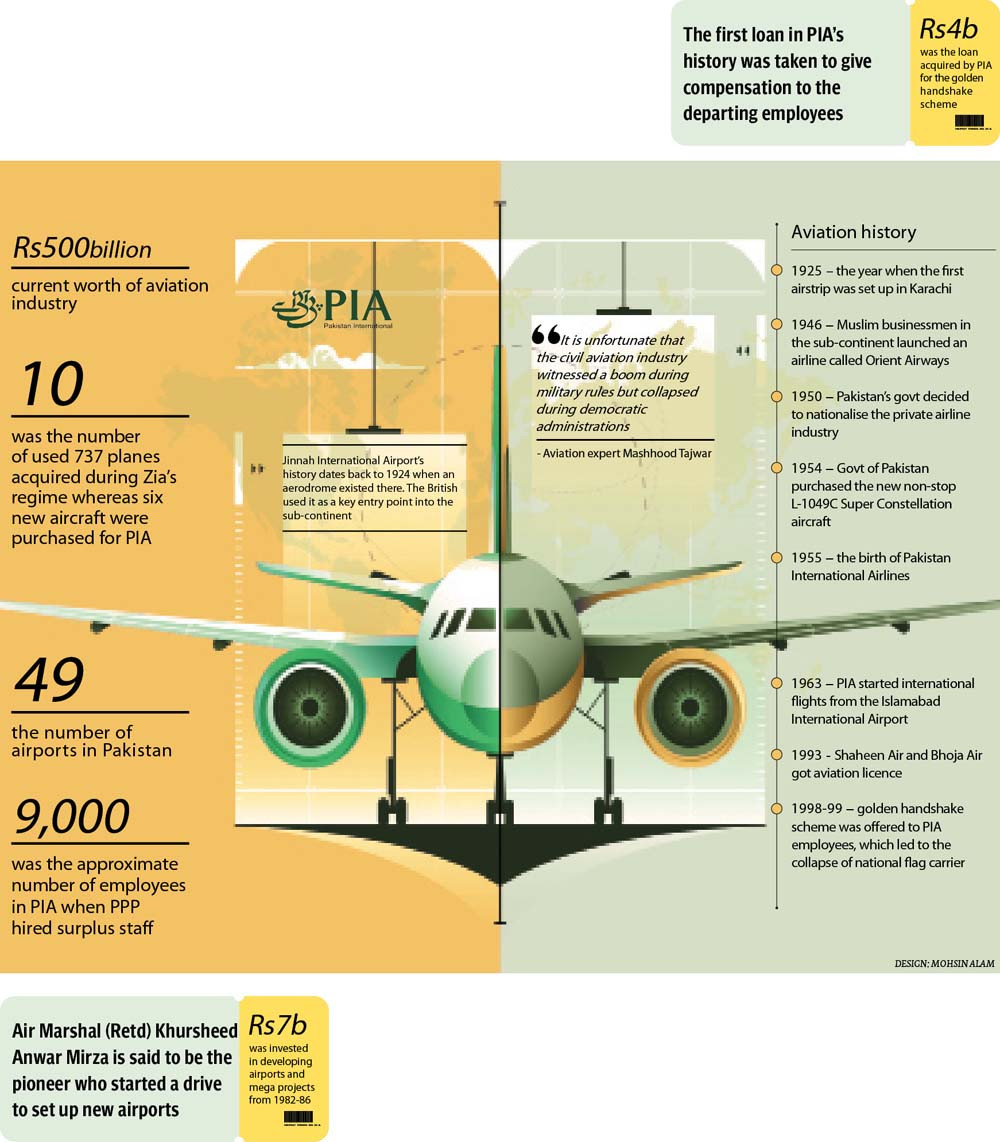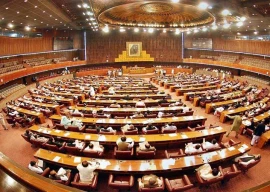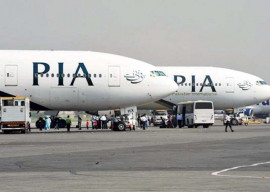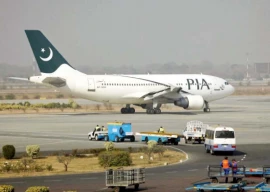
The aviation industry has experienced a mixture of ups and downs since the independence of Pakistan. It has different stories of success and failure to tell. Though it has made remarkable progress over decades, it has not come without encountering hard times on several occasions.
The aviation industry, which began its journey with only one airplane after partition, is now worth Rs500 billion.
Before partition, the British lay the foundation of the aviation industry to connect the sub-continent with Britain through the air route. Later, they extended it to destinations in Southeast Asia.
As the aviation industry started developing in the 1930s, British airline Imperial Airways and Indian carriers started flying from the sub-continent. Later, Tata Air Services, subsequently renamed Tata Airline, was launched in 1932.
Also, Muslim businessmen, on the reported request of Quaid-e-Azam Muhammad Ali Jinnah, launched an airline in 1946 called Orient Airways.
Earlier, the airline was based in Calcutta (now Kolkata), which later shifted its headquarters to Karachi and became Pakistan’s first air carrier. At the time of partition, nine airlines were operating in the sub-continent.
In 1950, Pakistan’s government, in a major shift, decided to nationalise the private airline industry. Experts blame frequent accidents for the nationalisation to ensure the security of air travellers. Another reason could be security fears due to the boiling tensions between Pakistan and India.
In a major revolution for the industry, the long-distance L-1049 Super Constellation airliner was introduced by the US aerospace company Lockheed in 1951.
Though the aircraft was expensive, it provided more comfort, had large capacity and a long flying range with high speed. Within three years, it was flying in the US with Eastern Airlines, Trans World Airlines, Air France, KLM and Trans-Canada Airlines using the aircraft. Air India acquired the airplane too.
For Pakistan, this was also a good opportunity as it could fly non-stop between Karachi in West Pakistan and Dhaka in the East. The plane was expensive and not easy for Orient to lease or purchase – still, the government of Pakistan purchased the new non-stop L-1049C Super Constellation in 1954.
The year 1955 saw the birth of Pakistan International Airlines (PIA) into which Orient Airways was merged. PIA launched its international service between Karachi and London via Cairo and Rome using the new aircraft but the industry remained under government control and lacked the required infrastructure to compete with the world.
The aviation industry’s take off
Air Marshal (Retd) Khursheed Anwar Mirza is said to be the pioneer behind the initiative of setting up new airports. Being the first director general of the Civil Aviation Authority (CAA) and having remained in service for five years from 1982-86, he made an investment of Rs5-7 billion in developing airports and other mega projects. He has to his credit the development of 24 airports across the country.
At present, Pakistan has 49 airports that serve the travelling needs of passengers, with major international airports situated in Karachi, Islamabad, Lahore and Peshawar. Other key airports are in Multan, Sialkot, Faisalabad, Quetta, Rahim Yar Khan, Turbat, Gwadar, DG Khan, Tharparkar, Sukkur and Skardu.
Jinnah International Airport
This airport in Karachi has a long history that serves as a key airstrip and stopover for many domestic and international airlines. Its history dates back to 1924 when an aerodrome existed there. The British used it as a key entry point into the sub-continent.
The first airstrip of Karachi (the Jinnah International Airport) has existed since 1925, and the first air route that the British started was from Karachi to Cairo.
According to reports, the British had built Black Hangar for the largest airship of that time, called R-101, which never reached Karachi as it crashed during its journey.
Karachi, however, had the prestige of hosting the first international airport in South Asia, which was established in April 1929. Imperial Airways was the first air carrier to land in the metropolitan, bringing passengers from London.
Later, more international routes were added between 1929 and 1933 – taking passengers to Australia, New Zealand, Hong Kong and Singapore.
Islamabad International Airport/ Chaklala Airbase
Chaklala Airbase, which was also being used for domestic and international flights until the Pakistan Muslim League-Nawaz (PML-N)’s previous tenure, also has a history dating back to the 1930s.
The airstrip was built by the British to be used as a standby strip during the Second World War.
Orient Airways, the first airline established by Muslim businessmen of the sub-continent, also operated its DC-3 aircraft through this airbase.
Following the creation of Pakistan, CAA started providing all facilities at the airbase. When the government declared Islamabad as the capital city of Pakistan in 1958, focus shifted to the development of Chaklala Airbase as it was being used by both the military and commercial flights.
PIA started its international flights from the Islamabad International Airport in 1963.
Decades later, the PML-N government built a new Islamabad airport, inaugurated in May 2018. Afterwards, all commercial flights were shifted to the new airport while the old airstrip was handed over to the Pakistan Army for military flights.
PIA: from legacy airline to financially grounded
In the beginning, PIA, which started operations in 1960, held a monopoly in the aviation industry. For a long time, PIA remained one of the most successful airlines in Asia.
Later, private airlines made their way into the aviation arena during the tenures of Pakistan Peoples Party (PPP) and the PML-N governments.
Shaheen Air acquired its aviation licence in 1993 and started operation the very next year. Similarly, Bhoja Air, owned by the Bhoja Group of Companies, also won a licence in 1993.
The two private-sector airlines kicked off operations during the tenure of the PPP administration. Apart from those, Airblue, owned by former PIA board of directors’ chairman Shahid Khaqan Abbasi, began flying on June 18, 2004.

Civil vs military impact
It is interesting to see how the respective civilian and military governments then contributed to the rise and subsequent fall of the aviation industry.
During the rule of military dictator General Ziaul Haq, the civil aviation industry got a welcome fillip. During his extended tenure, in 1982, the CAA was established and a huge investment of Rs4-5 billion was made to establish airports across the country. As many as 24 airports were built.
Expressing disappointment, aviation industry expert, Mashhood Tajwar said, “It is unfortunate that the civil aviation industry was only able to witness a boom during military rule but collapsed under democratic administrations.”
Aviation was perhaps the only industry to have flourished under military rule. Apart from setting up airports, 10 used 737 planes were acquired whereas six brand new aircrafts were purchased for induction into PIA during Zia’s regime.
Only one 707 airplane, however, was acquired during the rule of another military man, Ayub Khan. When General Pervez Musharraf was at the helm of affairs, 15 new planes were purchased, which included eight 777 and seven ATR aircrafts.
On the other hand, during the democratic governments of PPP and PML-N, no new airplane was purchased. Instead of inducting new aircraft, scores of people were hired into PIA and CAA on political grounds. Corruption and nepotism dealt a perilous blow to the national airline.
“All Pakistan’s new aircrafts were only acquired during the military regimes,” said Tajwar.
The situation worsened during PML-N’s tenure when Shahid Khaqan Abbasi was made PIA board chairman in 1998-99. Under his watch, PIA introduced a golden handshake scheme for employees who were only two years away from retirement. “The golden handshake scheme from 1998-99 was the beginning of the national flag carrier’s descent. PIA had to undertake heavy, unaffordable loans to offer golden handshakes to employees who were already leaving the airline…,” lamented Tajwar.
Under the scheme, PIA acquired a Rs4 billion loan for the first time in its history to compensate its departing employees – all while the airline was in dire need of infrastructural development.
Since the golden handshake scheme, PIA has not been able to recover or rely on its own resources, and much like Pakistan, it remains trapped in a vicious cycle of loans, repayments and losses.
Its problems were further compounded when PPP hired additional staff for PIA taking the employee strength of the airline to nearly 9,000.
Punching another hole into the finances of the airline, the democratic governments also started depriving PIA of its profitable international routes. Though it was mandatory to offer routes to overseas airlines after consulting PIA, the then governments amended the rules and allocated routes to the international air carriers without taking PIA on board. Now, all international routes have gone to Gulf-based air carriers.
At present, Pakistan’s civil aviation industry is dominated by foreign airlines, especially the Gulf carriers.
In the meantime, PIA has become a white elephant and a liability on the state. With its monopoly over and private airlines being unable to compete with the Gulf carriers, owned by the royal families, the turbulence this airline has had to endure in its short history is no less than a tale of despair – its seemingly final approach.
Published in The Express Tribune, February 12th, 2023.
Like Business on Facebook, follow @TribuneBiz on Twitter to stay informed and join in the conversation.

1732503274-0/Untitled-design-(43)1732503274-0-405x300.webp)
1732501636-0/Untitled-design-(42)1732501636-0-165x106.webp)

1732498967-0/Outer-Banks--(1)1732498967-0-165x106.webp)
1732086766-0/BeFunky-collage-(74)1732086766-0-165x106.webp)
1732486769-0/image-(8)1732486769-0-270x192.webp)














COMMENTS (1)
Comments are moderated and generally will be posted if they are on-topic and not abusive.
For more information, please see our Comments FAQ